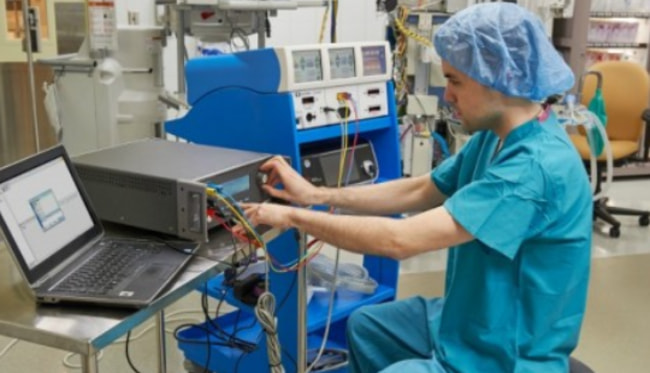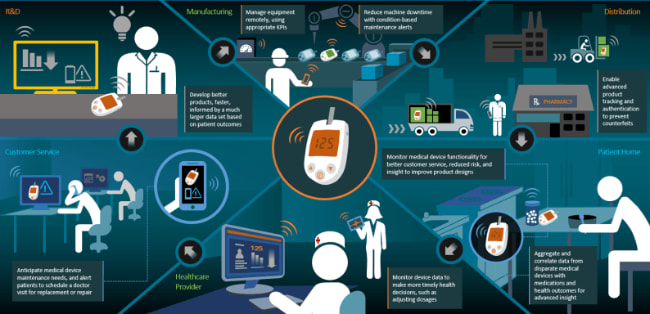
Qt continues to wander. Now we want to tell you about the application of this framework for an extremely important industry. It is the medical/healthcare sector as you might have guessed. It is completely amazing how this single framework can be used to create mobile games, complex desktop applications, and applications for the speed-critical automotive segment. And now it is possible also for the medical branch where every second and every touch can have critical importance. But it is a reality, and we want to share some cases where Qt has been used successfully for healthcare applications.
For all medical systems, any new innovation requires a thorough risk analysis. Final users should have very high confidence in the stability of such new devices. Thus, developers must be sure that the system design avoids unacceptable risks. And you know the Qt is accepted by a dozen international standards. Actually, no one would use Qt if this tool had not proceeded through seven circles of certification hell.
About certification
The Qt Company is proud to say that Qt is consistent with all medical requirements in the world. The framework is consistent with FDA, CEN, ISO, and IEC. Qt is applicable for developing FDA or EU Class II or Class III products such as surgical robots, infusion pumps, patient monitoring systems or medical imaging applications. Qt is a full member of AdvaMed and part of the Digital, Software and Standards working groups. Qt is included in QMed’s directory of pre-qualified suppliers to the medical device and in vitro diagnostics industry. And, Qt is part of The Massachusetts Medical Device Industry Council. Now you must use the Qt platform as though in deference to such an honorable list of certifications. But if you are looking for more proofs you are welcome to surf this article further.
Cross-platform and other Technical Benefits
As we covered in several previous articles, the Qt framework has several benefits against its software competitors. In short, Qt has the following good features:
C++ Based Framework
The main benefit of Qt is that this framework is based on the C++ programming language. Thus, the binary executable code of any program is fast on any platform and can be reused on many operating systems. Qt provides full native performance and total system control.
QML
Qt has a big advantage because it uses QML, its own declarative UI language. QML helps to create a compelling UI and completes the integration of the UI and backend to Linux embedded with one single toolkit. Also, due to Qt’s cross-platform capabilities, it is possible to easily reuse the code and port the software to laptops running Mac OS and Windows.
Easy to Create a Modern Interface
Qt has a set of WYSYWIG drag-and-drop tools. The Qt Quick Controls module contains ready-to-use buttons, sliders, dials, switches, and table views and makes them work on different screen sizes. These elements can either have a native look and feel for all major platforms or be customized. Also, it is possible to drag and drop 3D/2D UI elements and design your UI without the need to write any code.
Many ready libraries and components
Qt offers a lot of ready to use tools and libraries that help you to deploy final software in a short time frame.
There are several good examples of medical equipment and software solutions where Qt has been applied. We can list just a small sampling of them because the rest are an invisible part of an iceberg that is hidden under commercial licenses of non-disclosure data.
The Puretouch
Commonly the medical industry focuses on the mechanical aspects of medical devices. Medec company used Qt for the creation new automatic ventilator system software with very good user experience. A well-designed UX makes equipment more reliable for patients in a safety context. One of the most famous products is Caelus with its Puretouch UI. It is 18.5” touchscreen that displays all crucial information in a single glance. It is equipped with an AMD APU G-Series SoC.
The Qt Quick library was used for developing Puretouch UI. The most important feature of Qt Quick is to provide the ability to work with graphics smoothly and responsively. The Qt Quick module is the standard library used for creating QML applications.
The resulting UI allows users to swipe from one waveform to another smoothly. Finally, it is possible to write very fluid high-performance user interfaces. The safety critical user interface controls the gas mixer and displays all ventilation parameters and the UI can be easily configured, without the need to use any rotary knobs. All changes are effected directly on the display by the touch of a finger and provide the user with a full overview of all the safety critical functions that are vital to ensure patient safety.

As Medec’s representatives say, Qt Quick has really improved their design workflow. Designers can turn visual designs directly into dynamic prototypes in QML, skipping the step of creating clickable prototypes in third-party tools. The resulting QML code then serves as the basis for further development of the user interface.
Surgical Training Environment
The Orzone company applied Qt for the development of an amazing training environment named ORCAMP. It is a training simulator for surgical teams that includes an operating table, C-arm, and all needed control functions. The system integrates a wide range of different simulation technologies to create the most realistic training set up possible. Of course, no real patients needed for such practice.
One interesting thing to note is that at first Orzone tried to apply the .NET framework and C# programing language for the development of the graphical user interface (GUI) for ORCAMP. But afterward, the developers decided to use C++ and Qt for this project. The company’s representatives explained that real-time simulation was the most crucial part of the GUI’s requirements. That is why they switched over to C++ and Qt, because they ascertained that Qt is really the best GUI framework for C++. Additionally, Qt provides many ready-to-use components, many parts of which worked so well that many extra programming work hours were avoided.

Like with Medec, Orzone’s selection of Qt was also based on Qt’s cross-platform capabilities. The company plans to create applications for iOS and Windows Rt platforms that could be used by external consultants.
Linear Accelerator and Picture Archival and Communications System
One more example we have for you is a toolset developed by Claytronic Solutions company. The first one is a Linear Accelerator for radiation therapy. The device consists of a gantry and a treatment couch which can be controlled through a handheld remote. The controller can be connected to a PC through a microcontroller-based adapter. For testing and calibrating the linear accelerator, a Qt-based tool controller was developed. It is a simple but rich UI interface that allows the user to control the process easily even for an untrained hospital engineer. Their advanced new fully digitized radiotherapy machine has been a success that has generated repeated business.

One more important tool for the medical sector that has been developed with Qt is enterprise-level PACS (Picture Archival and Communications System) and TeleRadiology solution. Now it used at numerous hospitals and radiology centers across the world. It consists of a client and server side. The Qt framework is the backbone of the client-side desktop solution. It includes modules for editing DICOM (Digital Imaging and Communications in Medicine) files (images, datasets, and reports) and manages workflows. Client works on an IMX7 Duel Sabre Board under Embedded Linux.

Internet of Medical Things
Finally, we just cannot pass one more new feature of modern medical technology. It is about the Internet of Medical Things (or just IoMT) and the Qt framework is one of the most prominent players for programming UI of IoMT devices. Gartner predicts that 8.4 billion connected things will be in use worldwide in 2017. The Internet of Medical Things (IoMT) market, an emerging sub-sector of the IoT is expected to grow. It is expected that the IoMT annual growth rate will be 26.2% compared to 2016 and will reach $72 billion by 2021. The IoMT segment has a high barrier of entry. Due to the requirements of this ecosystem, there are specific considerations, including cybersecurity and data integrity. Qt is one of the frameworks that can look forward to further commercial success in the medical industry because of its certifications and flexibility.

Images are used in this article:
http://www.medecbenelux.be/wp-content/uploads/2016/04/Caelus.png
https://qt-web-uploads.s3.amazonaws.com/wp-content/uploads/2016/06/Orcamp_EV_module.jpg
http://www.claysol.com/
https://www.sesam-web.org/centres/centre/mentor-medicus/
https://2nznub4x5d61ra4q12fyu67t-wpengine.netdna-ssl.com/wp-content/uploads/2017/09/IoT-Healthcare.png







